BP辩论赛赛制介绍
BP辩论赛赛制介绍
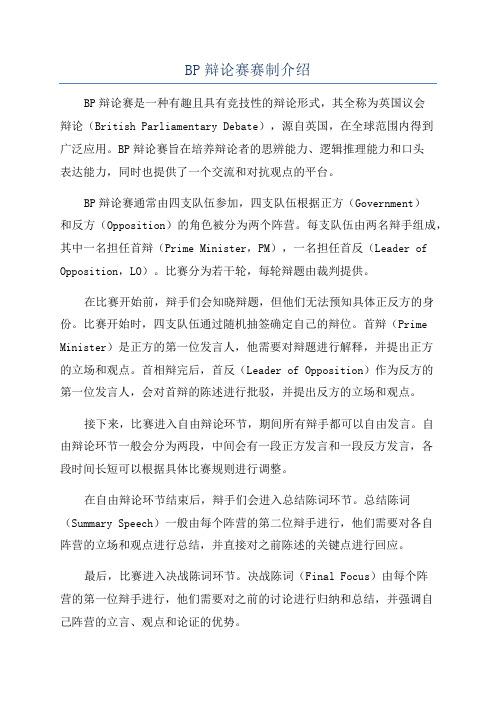
BP辩论赛赛制介绍BP辩论赛是一种有趣且具有竞技性的辩论形式,其全称为英国议会辩论(British Parliamentary Debate),源自英国,在全球范围内得到广泛应用。
BP辩论赛旨在培养辩论者的思辨能力、逻辑推理能力和口头表达能力,同时也提供了一个交流和对抗观点的平台。
BP辩论赛通常由四支队伍参加,四支队伍根据正方(Government)和反方(Opposition)的角色被分为两个阵营。
每支队伍由两名辩手组成,其中一名担任首辩(Prime Minister,PM),一名担任首反(Leader of Opposition,LO)。
比赛分为若干轮,每轮辩题由裁判提供。
在比赛开始前,辩手们会知晓辩题,但他们无法预知具体正反方的身份。
比赛开始时,四支队伍通过随机抽签确定自己的辩位。
首辩(Prime Minister)是正方的第一位发言人,他需要对辩题进行解释,并提出正方的立场和观点。
首相辩完后,首反(Leader of Opposition)作为反方的第一位发言人,会对首辩的陈述进行批驳,并提出反方的立场和观点。
接下来,比赛进入自由辩论环节,期间所有辩手都可以自由发言。
自由辩论环节一般会分为两段,中间会有一段正方发言和一段反方发言,各段时间长短可以根据具体比赛规则进行调整。
在自由辩论环节结束后,辩手们会进入总结陈词环节。
总结陈词(Summary Speech)一般由每个阵营的第二位辩手进行,他们需要对各自阵营的立场和观点进行总结,并直接对之前陈述的关键点进行回应。
最后,比赛进入决战陈词环节。
决战陈词(Final Focus)由每个阵营的第一位辩手进行,他们需要对之前的讨论进行归纳和总结,并强调自己阵营的立言、观点和论证的优势。
裁判会根据辩手们的口才、逻辑性、辩辞的前瞻性和在辩论中的表现来评分。
通常,辩手需要具备理解辩题能力、掌握话题知识、协作与对抗能力,以及语言表达的能力。
辩手们需要准备对立的观点,并能在辩论过程中灵活应对对方的观点。
英国议会辩论制介绍
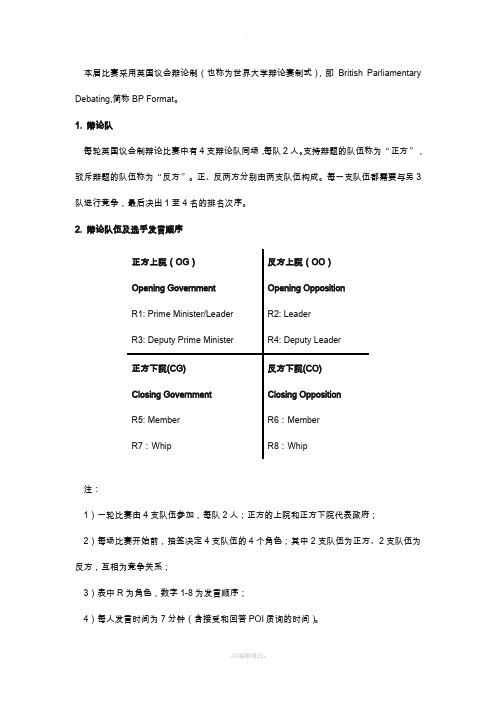
本届比赛采用英国议会辩论制(也称为世界大学辩论赛制式),即British Parliamentary Debating,简称BP Format 。
1. 辩论队每轮英国议会制辩论比赛中有4支辩论队同场,每队2人。
支持辩题的队伍称为“正方”,驳斥辩题的队伍称为“反方”。
正、反两方分别由两支队伍构成。
每一支队伍都需要与另3队进行竞争,最后决出1至4名的排名次序。
2. 辩论队伍及选手发言顺序注:1)一轮比赛由4支队伍参加,每队2人;正方的上院和正方下院代表政府;2)每场比赛开始前,抽签决定4支队伍的4个角色;其中2支队伍为正方、2支队伍为反方,互相为竞争关系;3)表中R 为角色,数字1-8为发言顺序;4)每人发言时间为7分钟(含接受和回答POI 质询的时间)。
正方上院(OG ) Opening Government R1: Prime Minister/Leader R3: Deputy Prime Minister 反方上院(OO ) Opening Opposition R2: Leader R4: Deputy Leader 正方下院(CG) Closing Government R5: Member R7:Whip 反方下院(CO) Closing Opposition R6:Member R8:Whip3. 发言计时1)每位辩手的发言的时间均为7分钟。
2)辩手提出“质询”(POI,Point of Information 简称)的时间应在第2到第6分钟之间。
“质询”是指在对方发言时,针对发言者正在申述的论点提出的本方观点。
3)发言计时从辩手开始说话为始;所有必要内容(包括说明、介绍等)均在计时范围内。
4)计时人员将在以下时间点向选手示意:第1分钟末响铃一次(允许开始提出“质询”);第6分钟末响铃一次(提出“质询”的时间结束);第7分钟末连续响铃两次(发言时间结束);7分15秒连续响铃(发言缓冲时间结束)。
英国议会辩论制介绍

本届比赛采用英国议会辩论制(也称为世界大学辩论赛制式),即British Parliamentary Debating,简称BP Format 。
1. 辩论队每轮英国议会制辩论比赛中有4支辩论队同场,每队2人。
支持辩题的队伍称为“正方”,驳斥辩题的队伍称为“反方”。
正、反两方分别由两支队伍构成。
每一支队伍都需要与另3队进行竞争,最后决出1至4名的排名次序。
2. 辩论队伍及选手发言顺序注:1)一轮比赛由4支队伍参加,每队2人;正方的上院和正方下院代表政府;2)每场比赛开始前,抽签决定4支队伍的4个角色;其中2支队伍为正方、2支队伍为反方,互相为竞争关系;3)表中R 为角色,数字1-8为发言顺序;4)每人发言时间为7分钟(含接受和回答POI 质询的时间)。
正方上院(OG ) Opening Government R1: Prime Minister/Leader R3: Deputy Prime Minister 反方上院(OO ) Opening Opposition R2: Leader R4: Deputy Leader 正方下院(CG) Closing Government R5: Member R7:Whip 反方下院(CO) Closing Opposition R6:Member R8:Whip3. 发言计时1)每位辩手的发言的时间均为7分钟。
2)辩手提出“质询”(POI,Point of Information 简称)的时间应在第2到第6分钟之间。
“质询”是指在对方发言时,针对发言者正在申述的论点提出的本方观点。
3)发言计时从辩手开始说话为始;所有必要内容(包括说明、介绍等)均在计时范围内。
4)计时人员将在以下时间点向选手示意:第1分钟末响铃一次(允许开始提出“质询”);第6分钟末响铃一次(提出“质询”的时间结束);第7分钟末连续响铃两次(发言时间结束);7分15秒连续响铃(发言缓冲时间结束)。
英文辩论bp规则

英文辩论bp规则
BP赛制要求参赛者在15分钟的准备时间后,做出7分钟的英文辩论陈词。
期间,对手随时会起立挑战或反驳参赛者,之后发言的辩手也会无情的攻击参赛者的观点。
全场辩论时间为1小时,每名辩手发言时间7分钟,可以不足7分钟,但是发言太短容易被评为打低分。
在每位辩手发言的第1-第6分钟(总计5分钟的时段内),对手可以随时提出Points of Information(POI),即各种挑刺攻击:比如重复、反讽你刚才说的经不起逻辑推掉的话,或者直接用犀利的例子来反驳你。
辩论比赛可能一天要参加4-6场,也就是一天要沉浸在英语中8小时。
讨论的话题也很广泛,包括政治、经济、国际形势、社会民生等。
bp辩论赛的赛制流程
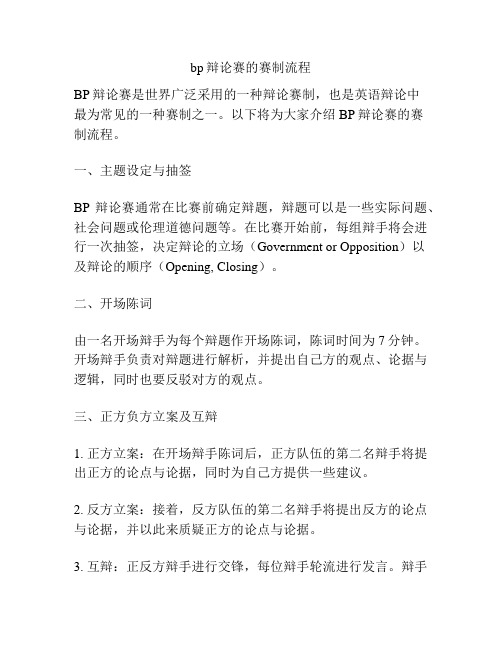
bp辩论赛的赛制流程BP辩论赛是世界广泛采用的一种辩论赛制,也是英语辩论中最为常见的一种赛制之一。
以下将为大家介绍BP辩论赛的赛制流程。
一、主题设定与抽签BP辩论赛通常在比赛前确定辩题,辩题可以是一些实际问题、社会问题或伦理道德问题等。
在比赛开始前,每组辩手将会进行一次抽签,决定辩论的立场(Government or Opposition)以及辩论的顺序(Opening, Closing)。
二、开场陈词由一名开场辩手为每个辩题作开场陈词,陈词时间为7分钟。
开场辩手负责对辩题进行解析,并提出自己方的观点、论据与逻辑,同时也要反驳对方的观点。
三、正方负方立案及互辩1. 正方立案:在开场辩手陈词后,正方队伍的第二名辩手将提出正方的论点与论据,同时为自己方提供一些建议。
2. 反方立案:接着,反方队伍的第二名辩手将提出反方的论点与论据,并以此来质疑正方的论点与论据。
3. 互辩:正反方辩手进行交锋,每位辩手轮流进行发言。
辩手在发言中可以提出自己的观点、举例、引用数据和逻辑等,以争取评委和观众的支持。
四、负方立案及互辩1. 反方立案:正反方辩手进行完首轮辩论后,反方队伍的第三名辩手将进一步说明反方的观点,并举出更多的例子和论据来支持。
2. 互辩:正反方辩手进行第二轮的辩论,依然轮流发言。
在这轮辩论中,辩手可以进一步深入辩题,提出更多的详细论述,加强论证的力度。
五、结辩1. 正方结辩:正方队伍的第四名辩手将进行结辩陈词,总结正方的观点、论据,并回顾整个辩题的辩论过程。
2. 反方结辩:随后,反方队伍的第四名辩手进行结辩陈词,总结反方的观点、理由,并给出反驳正方的推理。
六、评委点评与问答环节1. 评委点评:结辩后,评委会对辩论进行点评,评价辩手的辩论效果、论证能力、表达技巧和辩论逻辑等。
2. 问答环节:在点评之后,评委有权向辩手提问,以检验他们对辩题和辩论过程的理解程度。
七、颁奖和总结在评委点评和问答环节结束后,主持人将公布获奖队伍和个人,颁发奖项。
英国议会辩论赛制bp定义
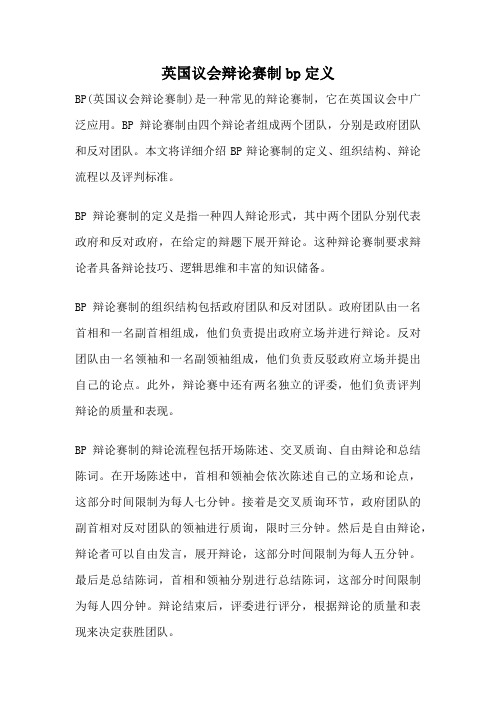
英国议会辩论赛制bp定义BP(英国议会辩论赛制)是一种常见的辩论赛制,它在英国议会中广泛应用。
BP辩论赛制由四个辩论者组成两个团队,分别是政府团队和反对团队。
本文将详细介绍BP辩论赛制的定义、组织结构、辩论流程以及评判标准。
BP辩论赛制的定义是指一种四人辩论形式,其中两个团队分别代表政府和反对政府,在给定的辩题下展开辩论。
这种辩论赛制要求辩论者具备辩论技巧、逻辑思维和丰富的知识储备。
BP辩论赛制的组织结构包括政府团队和反对团队。
政府团队由一名首相和一名副首相组成,他们负责提出政府立场并进行辩论。
反对团队由一名领袖和一名副领袖组成,他们负责反驳政府立场并提出自己的论点。
此外,辩论赛中还有两名独立的评委,他们负责评判辩论的质量和表现。
BP辩论赛制的辩论流程包括开场陈述、交叉质询、自由辩论和总结陈词。
在开场陈述中,首相和领袖会依次陈述自己的立场和论点,这部分时间限制为每人七分钟。
接着是交叉质询环节,政府团队的副首相对反对团队的领袖进行质询,限时三分钟。
然后是自由辩论,辩论者可以自由发言,展开辩论,这部分时间限制为每人五分钟。
最后是总结陈词,首相和领袖分别进行总结陈词,这部分时间限制为每人四分钟。
辩论结束后,评委进行评分,根据辩论的质量和表现来决定获胜团队。
BP辩论赛制的评判标准主要包括论点的逻辑性、论证的充分性、语言的表达能力、团队的合作默契以及辩论者的形象和风度。
评委会根据这些标准来评判辩论的优劣,并决定胜负。
BP辩论赛制是一种具有挑战性的辩论形式,它要求辩论者具备良好的辩论技巧和丰富的知识储备。
在辩论过程中,辩论者需要清晰地表达自己的立场和论点,并能够进行逻辑思考和有效的反驳。
同时,团队合作和个人形象也是评判的重要因素。
通过BP辩论赛制,辩论者可以锻炼自己的辩论能力和思维能力,提升自己的表达和沟通能力。
BP 赛制简介与裁判培训

整场比赛是如何进行的?
正方
反方
辩论地点
讲台
正上一辩 (首相) 正上二辩 (副首相)
反上一辩 (反对党领袖) 反上二辩 (反对党副领袖) 上院
正下一辩 (内阁成员) 正下二辩 (政府党鞭)
反下一辩 (反对党阁员) 反下二辩 (反对党党鞭)
下院
评委
评委主席(议长)
评委
发言顺序与时长
点名+公布对阵表 Process 公布辩题并开始准备 正上一辩发言 反上一辩发言 正上二辩发言 反上二辩发言 正下一辩发言 反下一辩发言 正下二辩发言 反下二辩发言 Time 30 mins 7 mins 7 mins 7 mins 7 mins 7 mins 7 mins 7 mins 7 mins
反驳
除了正上一辩外,其他七名辩手在立论前都应针对上一个辩手的发 言内容进行反驳; 选取最重要的点,而非最容易反驳的点来进行反驳;
反驳的论点最好与本方的立论相关
选取1-3个点即可,不可过多; 反驳时的基本语言结构(非强制):
他们说…… 我们说…… 因为…… 所以……
辩论场上还会发生什么?
每个人就做7分钟的演讲吗? 会不会太无聊啊?还是看自由 辩论过瘾啊! $%%&^*&(*&*(*)$
质询时间 (POI)
辩手可以提出质询 !
质询是在对方演讲过程中提出的问题、评论或是要求对方对某一 论点的澄清.
辩手提出的时间可以在1分钟之后,和6分钟以前,也就是说演讲 的第一分钟和最后一分钟,辩手不能打断对方发言,提出质询。 正在演讲的辩手可以选择接受,也可以选择拒绝质询
正上一辩定义(Definition): 留守老人:指…
BP 赛制简介与裁判培训

辩题实例二:
中国应该加强对国内的公共投资
正方立论
“根”与“须”——现状分析:西部农 村教育发展水平滞后,经济原因在其中 起关键作用;教育落后导致观念落后、 社会落后。 “解”——本论优势:将人口压力转变 为人力资源,改变落后观念,拉动地方 经济;满足人民需求,维护社会稳定。 “损”——积极防御:中国财政总实力 已能负担;保持教育投资与财政收入同 幅度增长是既定政策;“普九”实现已 为本政策奠定前提;部分地区试点成功。
整场比赛是如何进行的?
正方
反方
辩论地点
讲台
正上一辩 (首相) 正上二辩 (副首相)
反上一辩 (反对党领袖) 反上二辩 (反对党副领袖) 上院
正下一辩 (内阁成员) 正下二辩 (政府党鞭)
反下一辩 (反对党阁员) 反下二辩 (反对党党鞭)
下院
评委
评委主席(议长)
评委
发言顺序与时长
点名+公布对阵表 Process 公布辩题并开始准备 正上一辩发言 反上一辩发言 正上二辩发言 反上二辩发言 正下一辩发言 反下一辩发言 正下二辩发言 反下二辩发言 Time 30 mins 7 mins 7 mins 7 mins 7 mins 7 mins 7 mins 7 mins 7 mins
注意:正上一辩有对辩题的定义权,一般情况下只要PM对辩题的定义仍然具有
可辨性,反方不应挑战其定义。除非定义过于狭窄,或者正方对辩题的理解完全偏 离,那么反方可以挑战定义,但同时要承担证明新定义为什么可行的论证任务。
一辩搭架子
一辩亮剑 二辩补刀
二辩添内涵
辩题实例一:
解决农村留守老人问题的最佳途径应该是 通过非政府途径而非政府途径。
BP 赛制简介
英国议会制辩论赛制度
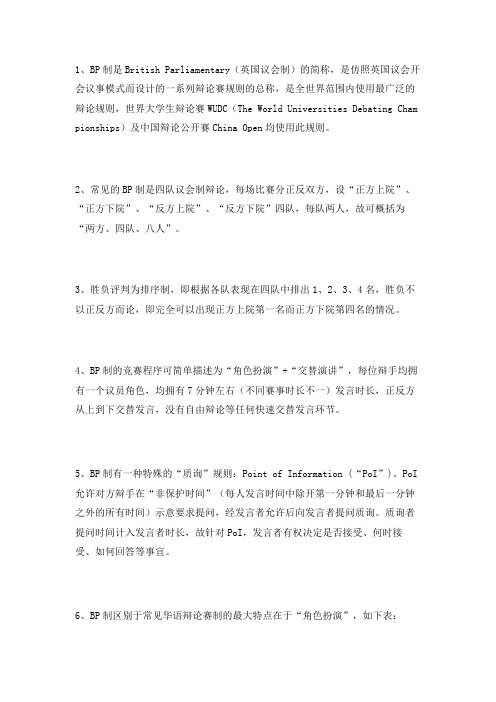
1、BP制是British Parliamentary(英国议会制)的简称,是仿照英国议会开会议事模式而设计的一系列辩论赛规则的总称,是全世界范围内使用最广泛的辩论规则,世界大学生辩论赛WUDC(The World Universities Debating Cham pionships)及中国辩论公开赛China Open均使用此规则。
2、常见的BP制是四队议会制辩论,每场比赛分正反双方,设“正方上院”、“正方下院”、“反方上院”、“反方下院”四队,每队两人,故可概括为“两方、四队、八人”。
3、胜负评判为排序制,即根据各队表现在四队中排出1、2、3、4名,胜负不以正反方而论,即完全可以出现正方上院第一名而正方下院第四名的情况。
4、BP制的竞赛程序可简单描述为“角色扮演”+“交替演讲”,每位辩手均拥有一个议员角色,均拥有7分钟左右(不同赛事时长不一)发言时长,正反方从上到下交替发言,没有自由辩论等任何快速交替发言环节。
5、BP制有一种特殊的“质询”规则:Point of Information (“PoI”)。
PoI 允许对方辩手在“非保护时间”(每人发言时间中除开第一分钟和最后一分钟之外的所有时间)示意要求提问,经发言者允许后向发言者提问质询。
质询者提问时间计入发言者时长,故针对PoI,发言者有权决定是否接受、何时接受、如何回答等事宜。
6、BP制区别于常见华语辩论赛制的最大特点在于“角色扮演”,如下表:正方上院第一位发言者首相(Prime Minister)正方一辩反方上院第一位发言者反对党领袖(Leader of the Opposition)反方一辩正方上院第二位发言者副首相(Deputy Prime Minister)正方二辩反方上院第二位发言者反对党副领袖(Deputy Leader of the O pposition)反方二辩正方下院第一位发言者政府阁员(Member of Government)正方三辩反方下院第一位发言者反对党阁员(Member of the Opposition)反方三辩正方下院第二位发言者政府党鞭(Government Whip)正方四辩反方下院第二位发言者反对党党鞭(Opposition Whip)反方四辩7、除一般的“立我方、批对方”的发言责任外,BP制中每个角色还有其独特的角色责任,对该责任的实现程度构成胜负评判的最大因素。
bp赛制
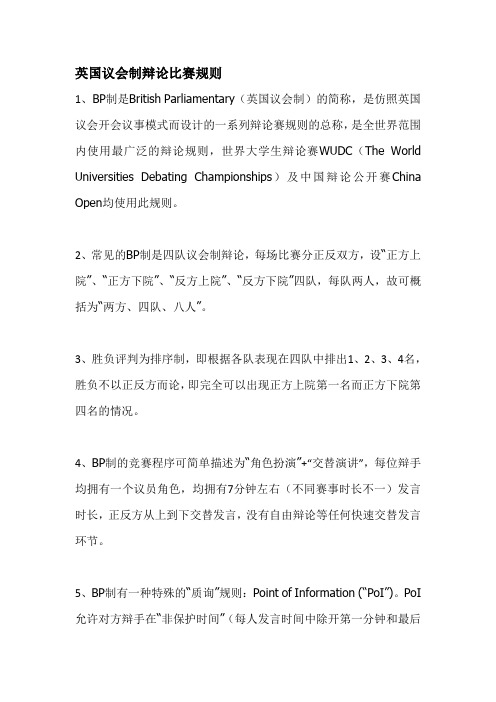
英国议会制辩论比赛规则1、BP制是British Parliamentary(英国议会制)的简称,是仿照英国议会开会议事模式而设计的一系列辩论赛规则的总称,是全世界范围内使用最广泛的辩论规则,世界大学生辩论赛WUDC(The World Universities Debating Championships)及中国辩论公开赛China Open均使用此规则。
2、常见的BP制是四队议会制辩论,每场比赛分正反双方,设“正方上院”、“正方下院”、“反方上院”、“反方下院”四队,每队两人,故可概括为“两方、四队、八人”。
3、胜负评判为排序制,即根据各队表现在四队中排出1、2、3、4名,胜负不以正反方而论,即完全可以出现正方上院第一名而正方下院第四名的情况。
4、BP制的竞赛程序可简单描述为“角色扮演”+“交替演讲”,每位辩手均拥有一个议员角色,均拥有7分钟左右(不同赛事时长不一)发言时长,正反方从上到下交替发言,没有自由辩论等任何快速交替发言环节。
5、BP制有一种特殊的“质询”规则:Point of Information (“PoI”)。
PoI 允许对方辩手在“非保护时间”(每人发言时间中除开第一分钟和最后一分钟之外的所有时间)示意要求提问,经发言者允许后向发言者提问质询。
质询者提问时间计入发言者时长,故针对PoI,发言者有权决定是否接受、何时接受、如何回答等事宜。
6、BP制区别于常见华语辩论赛制的最大特点在于“角色扮演”,如下表:7、除一般的“立我方、批对方”的发言责任外,BP制中每个角色还有其独特的角色责任,对该责任的实现程度构成胜负评判的最大因素。
择其精要:8、竞赛组织:一般采取赛前15分钟公布辩题、公布各队所处“赛位”(角色)。
辩题又称“动议”Motion,一般以“本院认为···”This House···的句式给出。
9、评判方式:比赛结束后评委闭门商议产生排序结论,其后由主评当场宣布结果并解释评判理由。
BP-英国议会制辩论赛制简介

与第一反方不重复的论点
下议院
第七位辩手–内阁党鞭
--从正方的角度总结整场辩论 --维护正方辩论体系,重点阐释
内阁成员的论点; --除反驳反对党成员提出的论点
外,不可引入任何新论点。
下议院
第八位辩手–反对党党鞭
--从反方的角度总结整场辩论 --维护反方辩论体系,重点阐释
BP 制辩论模式
• 四支队伍 • 职责与任务
四支队伍八位辩手
上议院
下议院
首相 副首相
反对党领袖 反对党副领袖
内阁成员 内阁党鞭
反对党成员 反对党党鞭
反驳与质询
• 反驳 Refutation
– 什么是反驳 – 反驳什么 – 四步驳论法
• 质询 Points of Information
什么是反驳
反方一队反对辩题的理由
第五位辩手–内阁成员
--简要支持正方一队的观点 --继续反驳反方一队的论点 --在保持与上院原则一致的情
况下,阐释一个或数个独立 的、与正方一队不重复的论 点 (即论点扩展)
下议院
第六位辩手–反对党成员
--简要支持反方一队的观点 --继续反驳正方一队的论点 --直接或间接反驳正方内阁
Member of Government Government Whip
Lower House
Leader of Opposition
Deputy Leader of Opposition
Member of Opposition
Opposition Whip
第一位辩手–首相
---合理诠释辩题,对辩题定义模 糊的范畴加以明确
英国BP制规则
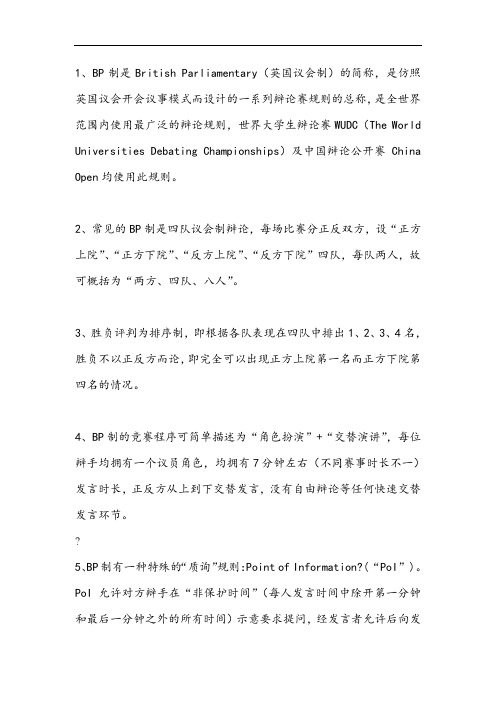
1、BP制是British Parliamentary(英国议会制)的简称,是仿照英国议会开会议事模式而设计的一系列辩论赛规则的总称,是全世界范围内使用最广泛的辩论规则,世界大学生辩论赛WUDC(The World Universities Debating Championships)及中国辩论公开赛China Open均使用此规则。
2、常见的BP制是四队议会制辩论,每场比赛分正反双方,设“正方上院”、“正方下院”、“反方上院”、“反方下院”四队,每队两人,故可概括为“两方、四队、八人”。
3、胜负评判为排序制,即根据各队表现在四队中排出1、2、3、4名,胜负不以正反方而论,即完全可以出现正方上院第一名而正方下院第四名的情况。
4、BP制的竞赛程序可简单描述为“角色扮演”+“交替演讲”,每位辩手均拥有一个议员角色,均拥有7分钟左右(不同赛事时长不一)发言时长,正反方从上到下交替发言,没有自由辩论等任何快速交替发言环节。
?5、BP制有一种特殊的“质询”规则:Point of Information?(“PoI”)。
PoI允许对方辩手在“非保护时间”(每人发言时间中除开第一分钟和最后一分钟之外的所有时间)示意要求提问,经发言者允许后向发言者提问质询。
质询者提问时间计入发言者时长,故针对PoI,发言者有权决定是否接受、何时接受、如何回答等事宜。
?6、BP制区别于常见华语辩论赛制的最大特点在于“角色扮演”,如下表:?正方上院第一位发言者首相(Prime Minister)正方一辩反方上院第一位发言者反对党领袖(Leader of the Opposition)反方一辩正方上院第二位发言者副首相(Deputy Prime Minister)正方二辩反方上院第二位发言者反对党副领袖(Deputy Leader of the反方二辩Opposition)正方下院第一位发言者政府阁员(Member of Government)正方三辩反方下院第一位发言者反对党阁员(Member of the Opposition)反方三辩正方下院第二位发言者政府党鞭(Government Whip)正方四辩反方下院第二位发言者反对党党鞭(Opposition Whip)反方四辩?7、除一般的“立我方、批对方”的发言责任外,BP制中每个角色还有其独特的角色责任,对该责任的实现程度构成胜负评判的最大因素。
bp赛制
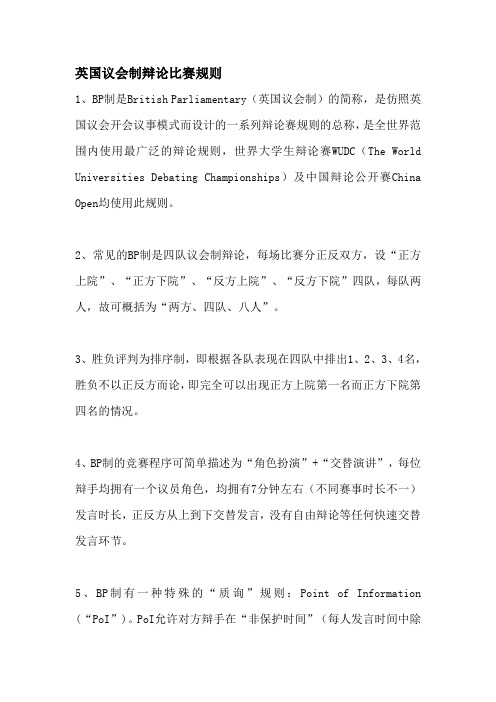
英国议会制辩论比赛规则1、BP制是British Parliamentary(英国议会制)的简称,是仿照英国议会开会议事模式而设计的一系列辩论赛规则的总称,是全世界范围内使用最广泛的辩论规则,世界大学生辩论赛WUDC(The World Universities Debating Championships)及中国辩论公开赛China Open均使用此规则。
2、常见的BP制是四队议会制辩论,每场比赛分正反双方,设“正方上院”、“正方下院”、“反方上院”、“反方下院”四队,每队两人,故可概括为“两方、四队、八人”。
3、胜负评判为排序制,即根据各队表现在四队中排出1、2、3、4名,胜负不以正反方而论,即完全可以出现正方上院第一名而正方下院第四名的情况。
4、BP制的竞赛程序可简单描述为“角色扮演”+“交替演讲”,每位辩手均拥有一个议员角色,均拥有7分钟左右(不同赛事时长不一)发言时长,正反方从上到下交替发言,没有自由辩论等任何快速交替发言环节。
5、BP制有一种特殊的“质询”规则:Point of Information (“PoI”)。
PoI允许对方辩手在“非保护时间”(每人发言时间中除开第一分钟和最后一分钟之外的所有时间)示意要求提问,经发言者允许后向发言者提问质询。
质询者提问时间计入发言者时长,故针对PoI,发言者有权决定是否接受、何时接受、如何回答等事宜。
6、BP制区别于常见华语辩论赛制的最大特点在于“角色扮演”,如下表:7、除一般的“立我方、批对方”的发言责任外,BP制中每个角色还有其独特的角色责任,对该责任的实现程度构成胜负评判的最大因素。
择其精要:8、竞赛组织:一般采取赛前15分钟公布辩题、公布各队所处“赛位”(角色)。
辩题又称“动议”Motion,一般以“本院认为···”This House···的句式给出。
9、评判方式:比赛结束后评委闭门商议产生排序结论,其后由主评当场宣布结果并解释评判理由。
BPdebate
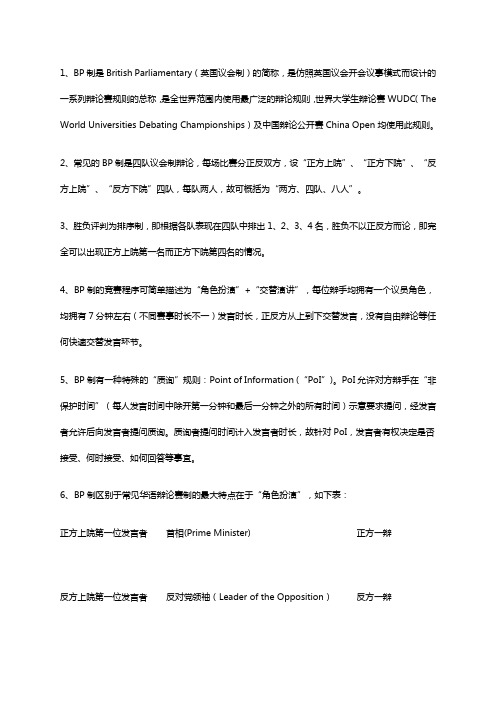
1、BP制是British Parliamentary(英国议会制)的简称,是仿照英国议会开会议事模式而设计的一系列辩论赛规则的总称,是全世界范围内使用最广泛的辩论规则,世界大学生辩论赛WUDC(The World Universities Debating Championships)及中国辩论公开赛China Open均使用此规则。
2、常见的BP制是四队议会制辩论,每场比赛分正反双方,设“正方上院”、“正方下院”、“反方上院”、“反方下院”四队,每队两人,故可概括为“两方、四队、八人”。
3、胜负评判为排序制,即根据各队表现在四队中排出1、2、3、4名,胜负不以正反方而论,即完全可以出现正方上院第一名而正方下院第四名的情况。
4、BP制的竞赛程序可简单描述为“角色扮演”+“交替演讲”,每位辩手均拥有一个议员角色,均拥有7分钟左右(不同赛事时长不一)发言时长,正反方从上到下交替发言,没有自由辩论等任何快速交替发言环节。
5、BP制有一种特殊的“质询”规则:Point of Information (“PoI”)。
PoI允许对方辩手在“非保护时间”(每人发言时间中除开第一分钟和最后一分钟之外的所有时间)示意要求提问,经发言者允许后向发言者提问质询。
质询者提问时间计入发言者时长,故针对PoI,发言者有权决定是否接受、何时接受、如何回答等事宜。
6、BP制区别于常见华语辩论赛制的最大特点在于“角色扮演”,如下表:正方上院第一位发言者首相(Prime Minister)正方一辩反方上院第一位发言者反对党领袖(Leader of the Opposition)反方一辩正方上院第二位发言者副首相(Deputy Prime Minister)正方二辩反对党副领袖(Deputy Leader of the反方上院第二位发言者反方二辩Opposition)正方下院第一位发言者政府阁员(Member of Government)正方三辩反方下院第一位发言者反对党阁员(Member of the Opposition)反方三辩正方下院第二位发言者政府党鞭(Government Whip)正方四辩反方下院第二位发言者反对党党鞭(Opposition Whip)反方四辩7、除一般的“立我方、批对方”的发言责任外,BP制中每个角色还有其独特的角色责任,对该责任的实现程度构成胜负评判的最大因素。
bp辩论赛的赛制流程
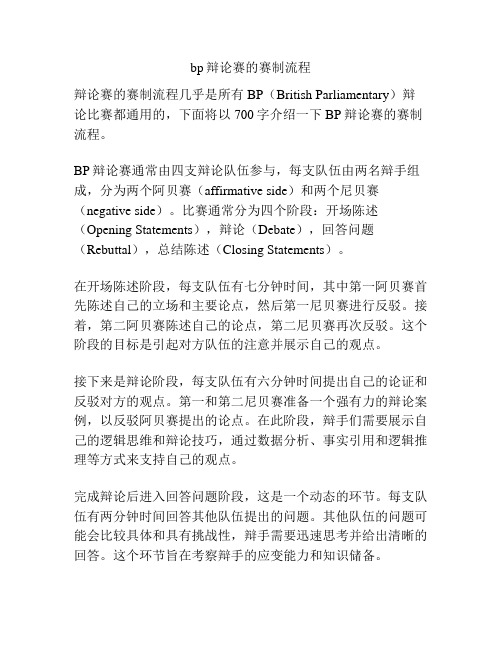
bp辩论赛的赛制流程辩论赛的赛制流程几乎是所有BP(British Parliamentary)辩论比赛都通用的,下面将以700字介绍一下BP辩论赛的赛制流程。
BP辩论赛通常由四支辩论队伍参与,每支队伍由两名辩手组成,分为两个阿贝赛(affirmative side)和两个尼贝赛(negative side)。
比赛通常分为四个阶段:开场陈述(Opening Statements),辩论(Debate),回答问题(Rebuttal),总结陈述(Closing Statements)。
在开场陈述阶段,每支队伍有七分钟时间,其中第一阿贝赛首先陈述自己的立场和主要论点,然后第一尼贝赛进行反驳。
接着,第二阿贝赛陈述自己的论点,第二尼贝赛再次反驳。
这个阶段的目标是引起对方队伍的注意并展示自己的观点。
接下来是辩论阶段,每支队伍有六分钟时间提出自己的论证和反驳对方的观点。
第一和第二尼贝赛准备一个强有力的辩论案例,以反驳阿贝赛提出的论点。
在此阶段,辩手们需要展示自己的逻辑思维和辩论技巧,通过数据分析、事实引用和逻辑推理等方式来支持自己的观点。
完成辩论后进入回答问题阶段,这是一个动态的环节。
每支队伍有两分钟时间回答其他队伍提出的问题。
其他队伍的问题可能会比较具体和具有挑战性,辩手需要迅速思考并给出清晰的回答。
这个环节旨在考察辩手的应变能力和知识储备。
最后是总结陈述阶段,每支队伍有四分钟时间总结自己的立场和主要论点。
辩手们在这个阶段可以再次强调自己的立场和观点,并对之前辩论中的争论点进行最后的回应。
这个环节需要辩手们有清晰的逻辑思维和语言表达能力,以确保自己的观点能够更加明确地传达给观众和评委。
整个辩论赛的总时间为约一个小时,其中每个阶段的时间都是有限的,辩手们需要在有限的时间内展示自己的辩论技巧和知识水平。
评委会根据辩手的辩论能力、逻辑思维和语言表达等方面进行评分,最终决定比赛的胜负。
以上就是BP辩论赛的赛制流程的大致介绍。
BP赛制介绍

BP(英国议会制辩论)赛制简介各角色主要职责(按出场数序排列)1.Prime minister:对辩题进行定义,给出全场辩论的主要框架,让辩题具有很强的可辨性2.Leader of Opposition:驳斥Prime minister演讲中的相关论点,树立己方的整体框架,为己方立论3.Deputy Prime Minister:驳斥Leader of Opposition的论点,进一步扩展Prime minister的论点,从不同角度证明自己的政策切实可行,不可重复Prime minister4.Deputy leader:驳斥Deputy Prime Minister相关论点,进一步确立己方论点5.Member:正反方Member的职责相似,主要是对辩题进一步深化,做出extension,要求不可与upper house论点重复,要更换角度,深挖或者拓展论点,正方Member驳斥Deputy leader的论点,反方Member则要驳斥正方Member的主要论点6.Whip:驳斥前一个人的论点,总结全场的Clashes,对己方的所有观点进行总结,但不可在此,再提出任何全新的观点(注:每人的演讲时间为7分钟)计时:每人进行7分钟左右的演讲,一分钟后,响铃一次,对方可以对演讲者进行质疑(详见P.O.I介绍),6分钟后响铃一次,之后对方不可再进行提问,7分钟时响铃两次,提醒选手结束演讲,7分15秒后连续响铃,选手必须结束演讲P.O.I(point of information):当一方选手演讲时,另一方可以利用P.O.I对选手的论点进行质疑,P.O.I只能在比赛开始一分钟后,比赛结束一分钟前提出,其余时间则为保护时间,不允许提P.O.IP.S.:全场比赛一共有四支队伍参赛,每支队伍2人,同一方的upper house 与lower house 是合作与竞争的关系,既要击败对方,通过或者不通过相关政策,又要击败自己的队友,让评委对自己的队伍又更深刻的印象,获得全场比赛的胜利。
Bp辩论赛规则和流程(3篇)

第1篇一、规则:1. 每场比赛由正反双方各选派4名辩手,分别担任一辩、二辩、三辩和四辩。
2. 辩题由主办方提供,正反双方各持一方观点。
3. 辩论时间:总共60分钟,其中立论阶段15分钟,攻辩阶段30分钟,总结陈词阶段15分钟。
4. 每位辩手发言时间不得超过规定时间,超时将扣除相应分数。
5. 辩论过程中,辩手不得离座,不得干扰对方辩手发言。
6. 辩论过程中,辩手不得使用侮辱性语言,不得恶意攻击对方辩手。
二、流程:1. 主席开场,介绍到场嘉宾、评委及双方辩手。
2. 正反双方一辩进行立论陈词,阐述本方观点。
3. 攻辩阶段,正反双方二辩、三辩依次进行提问和回答,时间各为30分钟。
4. 自由辩论阶段,正反双方四辩进行总结陈词,时间各为15分钟。
5. 评委根据双方辩手的辩论表现进行评分,评选出获胜队伍。
6. 评委对比赛进行点评,宣布比赛结果。
第2篇一、规则:1. 每场比赛由正反双方各选派4名辩手,正方一辩为领辩,反方一辩为领辩。
2. 辩题由组委会提前公布,正反双方在赛前一周内确定立场。
3. 辩论过程中,正反双方辩手不得相互攻击对方辩手,应围绕辩题展开讨论。
4. 辩论时间:正方一辩立论3分钟,反方一辩立论3分钟;攻辩阶段,每轮攻辩时间不超过1分钟;自由辩论阶段,正反双方共用时8分钟;总结陈词阶段,正反双方各3分钟。
5. 评委由组委会邀请专家、学者、教师等组成,对辩论过程进行评分。
二、流程:1. 主席介绍到场嘉宾、评委及双方辩手。
2. 正反双方一辩进行立论陈词。
3. 攻辩阶段:正方二辩提问,反方二辩或三辩回答;反方二辩提问,正方二辩或三辩回答;正方三辩提问,反方二辩或三辩回答;反方三辩提问,正方二辩或三辩回答。
4. 攻辩小结:正方一辩、反方一辩分别进行攻辩小结。
5. 自由辩论阶段:正反双方辩手轮流发言。
6. 总结陈词阶段:正方四辩、反方四辩分别进行总结陈词。
7. 评委点评:评委对双方观点及辩论过程进行点评。
8. 公布比赛结果:根据评委评分,确定胜方。
Bp辩论赛流程及规则(3篇)

第1篇一、流程:1. 主持人宣布比赛开始,介绍到场嘉宾及评委。
2. 介绍辩题,并说明双方立场。
3. 正方一辩开篇立论,3分钟;反方一辩开篇立论,3分钟。
4. 正方二辩驳立论,2分钟;反方二辩驳立论,2分钟。
5. 正方三辩提问,反方一、二、四辩回答,每个问题不超过15秒,累计回答时间为1分30秒;反方三辩提问,正方一、二、四辩回答,规则同上。
6. 正方三辩质辩小结,1分30秒;反方三辩质辩小结,1分30秒。
7. 自由辩论,正反双方轮流发言,共用时8分钟。
8. 总结陈词,反方四辩总结陈词,3分钟;正方四辩总结陈词,3分钟。
9. 评委点评。
10. 主持人宣布比赛结果。
二、规则:1. 辩手需在规定时间内完成自己的发言,超时将视为违规。
2. 辩手不得抄袭他人观点,如有抄袭行为,将被取消比赛资格。
3. 辩手在比赛中应尊重对方辩手,不得使用侮辱性语言。
4. 评委根据辩手的逻辑推理、论据分析、语言表达等方面进行评分。
5. 比赛结束后,评委对辩手的表现进行点评,并提出改进建议。
第2篇一、流程:1. 开场:主持人宣布辩论赛开始,介绍到场嘉宾、评委、参赛队伍及辩题。
2. 陈词:正方一辩、反方一辩分别进行3分钟的开篇陈词。
3. 攻辩:正方二辩、反方二辩依次进行攻辩,提问与回答环节,每次提问不超过30秒,回答不超过1分钟。
4. 自由辩论:正方、反方辩手轮流发言,每次发言不超过1分钟,共计8分钟。
5. 总结陈词:正方四辩、反方四辩分别进行3分钟的总结陈词。
6. 评委点评:评委对比赛进行点评。
7. 公布结果:主持人宣布比赛结果。
二、规则:1. 辩手需遵守比赛规则,尊重对手,不得侮辱、诽谤。
2. 每位辩手发言时间不得超过规定时间,超时将被扣分。
3. 辩论过程中,不得离座、离场,不得随意走动。
4. 辩手应积极提问、回答,围绕辩题展开讨论。
5. 评委根据辩手的表现、团队配合、观点阐述等方面进行评分。
6. 比赛结果由评委投票决定,票数最高的一方获胜。
BP辩论赛赛制介绍

∙General rules1. IntroductionThe “FLTRP CUP” National English Debating Competition(hereafter referred to as “the Competition”) inaugurated in 1997 is the onlynational English debating event in ... ∙General rules1. IntroductionThe “FLTRP CUP” Nationa l English Debating Competition(hereafter referred to as “the Competition”) inaugurated in 1997 is the onlynational English debating event in China. The FLTRP CUP National EnglishDebating Competition is jointly hosted by the Foreign Language Teaching andResearch Press Cambridge University Press and the International Debate EducationAssociation (IDEA) coordinated by the China English Language EducationAssociation (CELEA) English Speaking Union (ESU) English Language Learningmagazine (ELL) and sponsored by CASIO (Shanghai).2. Competition FormatThe Competition shall be conducted in the BritishParliamentary Debating Style (also known as the World Universities DebatingChampionships Style) as defined in Part 2.3. Required qualificationsfor the competitionA debater must be a registeredfull-time undergraduate of Chinese nationality in a Chinese territoryeducational institution. Those who have wonoverseas awards of the past CCTV CUP English Speaking Contest or past FLTRP CUPNational English Debating Competition are excluded from participating in theFLTRP Cup.The British Parliamentary format1. The TeamsFour teams of two debaters participate in each British Parliamentarydebate round. The teams supporting themotion are referred to as the "Proposition." The teams arguingagainst the motion are known as the "Opposition" teams. Two teams represent the Proposition: theOpening Proposition and the Closing Proposition. Two teams represent the Opposition: theOpening Opposition and the Closing Opposition. Each of these teams competes against all other teams in the round andwill be ranked 1st through 4th at the conclusion of thedebate.Opening PropositionOpening OppositionClosing PropositionClosing Opposition2. Speaker OrderEach speaker will present a single speech in the order prescribedbelow. SpeakerCommon Titles for SpeakerTimeOpening Proposition Team 1st speaker"Prime Minister" or “Leader of the Proposition”7 minutesOpening Opposition Team 1st speaker"Leader of the Opposition"7 minutesOpening Proposition Team 2nd speaker"Deputy Prime Minister" or "Deputy Leader of the Proposition"7 minutesOpening Opposition Team 2nd speaker"Deputy Leader of the Opposition"7 minutesClosing Proposition Team 1st speaker"Member of the Proposition" "7 minutesClosing Opposition Team 1st speaker"Member of the Opposition"7 minutesClosing Proposition Team 2nd speaker"Proposition Whip"7 minutesClosing Opposition Team 2nd speaker"Opposition Whip"7 minutes3. Speech timingEach speech will be 7 minutes. Points of Information are allowed after the first minute and before thelast minute of all speeches.Timing of the speech begins whenthe speaker begins speaking; all material—including acknowledgementsintroductions etc.—will be timed. Atimekeeper will provide a series of signals during each speech as follows:∙ TimingSignal1:00Single ring of a bell (POIs allowed)6:00Single ring of a bell (POIs no longer allowed)7:00Double ring of a bell (Conclusion of speaking time)7:15Continuous ringing (Conclusion of ...∙ TimingSignal1:00Single ring of a bell (POIs allowed)6:00Single ring of a bell (POIs no longer allowed)7:00Double ring of a bell (Conclusion of speaking time)7:15Continuous ringing (Conclusion of grace period)Once the double ring has sounded speakers have a 15-second ‘grace period’ during which th ey should conclude their remarks. The grace period is not a time for new matter to be introduced and any new matter offered in the grace period may be discounted by the adjudicators. Speakers continuing after this ‘grace period’ may be penalized by the adjudication panel.4.Speaker RolesEach speaker has a role and each speech has a specific purpose. The descriptions of speaker roles listed below are suggestive and are not intended to be exhaustive or exclusive. For reasons that vary from debate to debate speakers may sometimes need to fulfill roles not mentioned here and speeches may be constructed to serve other purposes as long as Proposition speakers affirm the motion and Opposition speakers oppose it.All speakers except the final speakers for the Proposition and Opposition (Proposition and Opposition Whips) should introduce new material. All debaters should refute the opposing teams’ arguments except the Prime Minister.SpeakerRole and Responsibility"Prime Minister" or "Leader of the Proposition”The first speaker's responsibility is to present a case supporting the motion. The primary role of Opening Proposition team initiated in this speech is to establish the foundation for meaningful debate on the motion.“Leader of the Opposition"The Opening Opposition's primary team role is to counter the first Proposition team's case through direct or indirect refutation and/or provide substantive arguments against the motion."Deputy Prime Minister"This speaker should refute the Leader of the Opposition's speech and further develop the Opening Proposition team's case."Deputy Leader of the Opposition"This speaker supports his or her teammate answering objections from the other side and introducing additional arguments or support."Member of the Proposition"This speaker should support the position developed by the Opening Proposition team by introducing an extension. A successful extension will develop a distinct argument identity for the Closing Proposition team while supporting the Opening Proposition team. The Member of the Proposition may also refute the arguments made by the Deputy Leader of the Opposition."Member of the Opposition"This speaker should support the position developed by the Opening Opposition team and must also introduce an extension. As with the Member Proposition the Member Opposition’s extension will be most successful if it establishes a unique argument identity that distinguishes the Closing from the Opening Opposition while continuing the general direction of argument initiated by the Opening Opposition. The Member Opposition may also directly or indirectly refute the arguments of the Member Proposition.∙"Proposition Whip"This speaker summarizes the Proposition’s arguments and summarizes the refutation of the Opposition side. With the exception of refuting the Member Opposition’s extension the ...∙ "Proposition Whip"This speaker summarizes the Propos ition’s arguments and summarizes the refutation of the Opposition side. With the exception of refuting the Member Opposition’s extension the speaker should not introduce positive (new) matter."Opposition Whip"This speaker summarizes opposition to the extension and makes reply to each team's position in the debate. This speaker should not introduce positive (new) matter.5.The MotionsA single motion will be announced thirty minutes prior to the beginning of the debate and will be presented to all debaters simultaneously in a general assembly. A different motion will be used for each round.Motions typically focus on current issues or timeless controversies and are phrased in a way that is intended to be specific and unambiguous.6.Focus and content of debatesBritish Parliamentary debating is a contest of ideas in which the Proposition teams are responsible for providing reasons why the motion is true and the Opposition teams are responsible for providing reasons why the motion is not true or why the Proposition has failed to prove the motion true. All teams have a responsibility to refute either directly or indirectly arguments presented by the opposing side.Motions are written in plain language. The debaters—particularly the Opening Proposition team—should respect the meaning and focus of the motion. While the Opening Proposition team may clarify the meaning of terms in the motion they should not attempt to alter the meaning of the motion. The Leader of the Proposition should provide any clarification of terms at the beginning of his or her speech.In the majority of cases the clarification provided by the Opening Proposition team will serve as an adequate foundation for the rest of the debate. Should the Opening Proposition fail to make clear the focus of the debate or if the interpretation offered by the Opening Proposition team completely inhibits meaningful debate or completely misinterprets the meaning the motion the Opening Opposition may offer clarification of the terms of the motion. No teams beyond the Opening Proposition and Opening Opposition may substantially modify the terms of the motion.7.PreparationAll debates shall commence 30 minutes after the motion has been announced. Debaters may consult any written materials during the preparation time. Except for the designated CASIO electronic dictionary no access to other electronic media or electronic storage or retrieval devices is permittedafter motions have been released. Printed and prepared materials may be accessed during a debate.Debaters may confer with their debate partner during preparation time. Debaters may also confer with one tutor from their university during the preparation time.Debaters may not confer with any other individuals (i.e.: coaches other debaters trainers adjudicators etc.) during the preparation time.The Opening Proposition shall have the right to prepare in the debating venue. All other teams must prepare in separate locations.∙ Teams must arrive at their chamber within five minutes of the time of commencement of debate. Teams failing to arrive in time will forfeit the debate at the discretion of the Chair of the panel.8 ...∙ Teams must arrive at their chamber within five minutes of the time of commencement of debate. Teams failing to arrive in time will forfeit the debate at the discretion of the Chair of the panel.8.Points of InformationDebaters may request a point of information (either verbally or by rising) at any time after the first minute and before the last minute of any speech.The debater holding the floor may accept or refuse any points of information within this time. If accepted the debater making the request has fifteen seconds to make a statement or ask a question. During the point of information the speaking time of the floor debater continues. Management of Points of Information—for both the debaters offering and answering Points of Information—will be considered in the adjudicators’ ranking of teams and assignment of individual speaker points.No other parliamentary points such as points of order or points of personal privilege are allowed.Competition Administration1.Structure of the competitionThe Competition shall be run in two main phases: phase one known as the ‘Preliminary’ rounds and phase two known as the ‘Elimination’ rounds. There shall be one mock round eight Preliminary rounds and fourElimination rounds. All teams entered in the Competition shall participate in the Preliminary rounds. Only the top 32 teams will participate in the Elimination rounds.2.The Mock RoundThe mock round will be held as part of the training for the FLTRP Cup. The pairing of the mock round will be random and the results of the mock round will not count for the Preliminary or Elimination rounds.3.Pairing the Preliminary RoundsIf the total number of teams entered in the Competition is not divisible by four or during the Competition the withdrawal of teams results in a total number of teams not divisible by four the tournament administrators shall employ “swing teams” to fill vacant slots. The swing teams shall be ranked in each round relative to the teams against whom they compete (i.e.: if a swing team is the best team in a round they should be ranked 1st) but will be ineligible to advance to the Elimination rounds.The first round of the Competition will be paired randomly.At the conclusion of each preliminary round (except for the last round) teams shall be ranked in order of their aggregate team points accumulated by the team; from highest aggregate to lowest.The teams should then be divided up into pools of teams with the same amount of aggregate team points with pools being ranked from highest aggregate to lowest.If any pool (the “Upper Pool”) consists of an amount of teams equivalent to a number that is not divisible by four then teams from the pool ranking immediately below that pool (the “Lower Pool”) may be promoted to the Upper Pool so that the Upper Pool consists of a number of teams that is divisible by four. The team selected for promotion must be selected randomly from the Lower Pool. If promotion of a team to the Upper Pool results in a number of teams in the Lower Pool not divisible by four each consecutive pool should be adjusted in the same fashion until all pools have a number of teams divisible by four.Once the pools have been adjusted the pools are paired into debates of four teams in such a way that equalizes the team positions in which each team will debate. The pairing should promote to th ...Once the pools have been adjusted the pools are paired into debates of four teams in such a way that equalizes the team positions in which each team will debate. The pairing should promote to the greatest extent possible equality of distribution of team positions over the Preliminary rounds.Preliminary rounds 1-6 shall be “open adjudication” with oral adjudications given by the adjudication panel following each debate. Preliminary rounds 7 & 8 shall be “closed” with no oral adjudication (including any disclosure of the results of the round) permitted.3.Selection of teams for the Elimination RoundsAt the conclusion of the Preliminary rounds the teams shall be ranked in order according to 1) their aggregate team points from the eight preliminary rounds; 2) their aggregate team scores as determined by combining the individual speaker scores for each team member; 3)head-to-head matches between two teams tied for a rank; and 4) preponderance of first place rankings. If after these tie-breakers are applied a tie still exists the rankings of the tied teams shall be determined by drawing lots. The top thirty-two (32) teams ranked by this method shall be selected to compete in the Elimination rounds.4.Pairing of Elimination RoundsThere shall be four elimination rounds: Octofinals Quarterfinals Semifinals and Finals. Each Elimination round shall be paired by “folding” the bracket of the top 32 teams as determined by their aggregate team points. For example the first Octofinal round would be comprised of the teams ranked 1st 16th 17th and 32nd. The second Quarterfinal round would be comprised of the teams ranked 2nd 15th 18th and 31st and so on.5.Advancement of teams through elimination roundsAt the conclusion of each Elimination round debate (with the exception of the Final round) the adjudication panel shall select two of the four teams to advance to the next Elimination round. Those teams assume the highest rankings available in their room (i.e.: for the purposes of ranking the two teams to emerge from the first Octofinal round will be ranked 1st and 16th regardless of their ranking prior to the Octofinal round).For the Final round the adjudication panel shall select one Championship team. All other teams in the Final round will be designated “Finalists.”6.Access to debatesIn preliminary rounds observers may watch a debate round with the consent of the teams participating in the round. Similarly those interested in photographing or recording video of the preliminary rounds must obtain the consent of the debaters participating in the round.Elimination rounds are open to all observers subject to the。
辩论---英国议会制(BP)赛制介绍
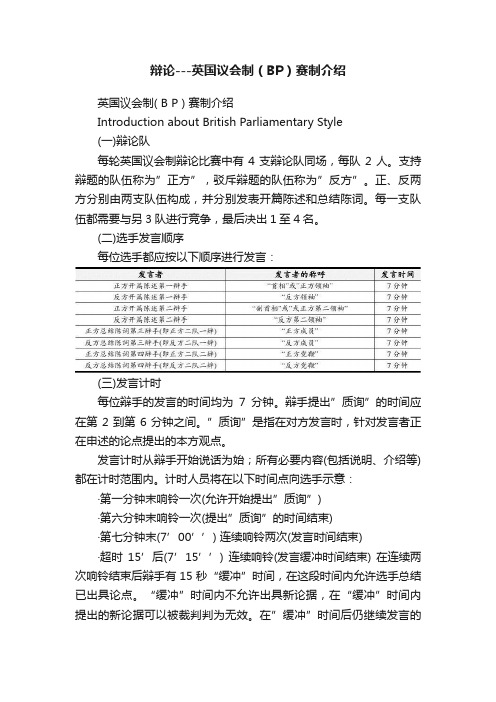
辩论---英国议会制(BP)赛制介绍英国议会制( B P ) 赛制介绍Introduction about British Parliamentary Style(一)辩论队每轮英国议会制辩论比赛中有4支辩论队同场,每队2人。
支持辩题的队伍称为”正方”,驳斥辩题的队伍称为”反方”。
正、反两方分别由两支队伍构成,并分别发表开篇陈述和总结陈词。
每一支队伍都需要与另3队进行竞争,最后决出1至4名。
(二)选手发言顺序每位选手都应按以下顺序进行发言:(三)发言计时每位辩手的发言的时间均为7分钟。
辩手提出”质询”的时间应在第2到第6分钟之间。
”质询”是指在对方发言时,针对发言者正在申述的论点提出的本方观点。
发言计时从辩手开始说话为始;所有必要内容(包括说明、介绍等)都在计时范围内。
计时人员将在以下时间点向选手示意:·第一分钟末响铃一次(允许开始提出”质询”)·第六分钟末响铃一次(提出”质询”的时间结束)·第七分钟末(7’00’’) 连续响铃两次(发言时间结束)·超时15’后(7’15’’) 连续响铃(发言缓冲时间结束) 在连续两次响铃结束后辩手有15秒“缓冲”时间,在这段时间内允许选手总结已出具论点。
“缓冲”时间内不允许出具新论据,在“缓冲”时间内提出的新论据可以被裁判判为无效。
在”缓冲”时间后仍继续发言的辩手将被裁判团扣分。
(四)辩手角色分配每个选手都有一个定位,每一个发言都有其特殊目的。
下面列出的辩手角色描述具有借鉴作用,并非必须完全遵循。
根据不同的辩论形式,辩手有时需要在完成本角色需要说明的部分之外,还要表述其它方面的观点,在正方支持辩题、反方驳斥辩题的基础上,发言结构仍需满足其它论证的需要。
除了辩论双方的第四辩手,其它所有辩手都需要提出自己的论点。
除了”首相”,所有辩手都要反驳对方辩友的辩论。
(五)辩题辩题将在辩论开始之前15分钟,在全部辩手参加的公开集会上公布,每轮的辩题都不相同。
- 1、下载文档前请自行甄别文档内容的完整性,平台不提供额外的编辑、内容补充、找答案等附加服务。
- 2、"仅部分预览"的文档,不可在线预览部分如存在完整性等问题,可反馈申请退款(可完整预览的文档不适用该条件!)。
- 3、如文档侵犯您的权益,请联系客服反馈,我们会尽快为您处理(人工客服工作时间:9:00-18:30)。
∙General rules1. IntroductionThe “FLTRP CUP” National English Debating Competition(hereafter referred to as “the Competition”) inaugurated in 1997 is the onlynational English debating event in ... ∙General rules1. IntroductionThe “FLTRP CUP” Nationa l English Debating Competition(hereafter referred to as “the Competition”) inaugurated in 1997 is the onlynational English debating event in China. The FLTRP CUP National EnglishDebating Competition is jointly hosted by the Foreign Language Teaching andResearch Press Cambridge University Press and the International Debate EducationAssociation (IDEA) coordinated by the China English Language EducationAssociation (CELEA) English Speaking Union (ESU) English Language Learningmagazine (ELL) and sponsored by CASIO (Shanghai).2. Competition FormatThe Competition shall be conducted in the BritishParliamentary Debating Style (also known as the World Universities DebatingChampionships Style) as defined in Part 2.3. Required qualificationsfor the competitionA debater must be a registeredfull-time undergraduate of Chinese nationality in a Chinese territoryeducational institution. Those who have wonoverseas awards of the past CCTV CUP English Speaking Contest or past FLTRP CUPNational English Debating Competition are excluded from participating in theFLTRP Cup.The British Parliamentary format1. The TeamsFour teams of two debaters participate in each British Parliamentarydebate round. The teams supporting themotion are referred to as the "Proposition." The teams arguingagainst the motion are known as the "Opposition" teams. Two teams represent the Proposition: theOpening Proposition and the Closing Proposition. Two teams represent the Opposition: theOpening Opposition and the Closing Opposition. Each of these teams competes against all other teams in the round andwill be ranked 1st through 4th at the conclusion of thedebate.Opening PropositionOpening OppositionClosing PropositionClosing Opposition2. Speaker OrderEach speaker will present a single speech in the order prescribedbelow. SpeakerCommon Titles for SpeakerTimeOpening Proposition Team 1st speaker"Prime Minister" or “Leader of the Proposition”7 minutesOpening Opposition Team 1st speaker"Leader of the Opposition"7 minutesOpening Proposition Team 2nd speaker"Deputy Prime Minister" or "Deputy Leader of the Proposition"7 minutesOpening Opposition Team 2nd speaker"Deputy Leader of the Opposition"7 minutesClosing Proposition Team 1st speaker"Member of the Proposition" "7 minutesClosing Opposition Team 1st speaker"Member of the Opposition"7 minutesClosing Proposition Team 2nd speaker"Proposition Whip"7 minutesClosing Opposition Team 2nd speaker"Opposition Whip"7 minutes3. Speech timingEach speech will be 7 minutes. Points of Information are allowed after the first minute and before thelast minute of all speeches.Timing of the speech begins whenthe speaker begins speaking; all material—including acknowledgementsintroductions etc.—will be timed. Atimekeeper will provide a series of signals during each speech as follows:∙ TimingSignal1:00Single ring of a bell (POIs allowed)6:00Single ring of a bell (POIs no longer allowed)7:00Double ring of a bell (Conclusion of speaking time)7:15Continuous ringing (Conclusion of ...∙ TimingSignal1:00Single ring of a bell (POIs allowed)6:00Single ring of a bell (POIs no longer allowed)7:00Double ring of a bell (Conclusion of speaking time)7:15Continuous ringing (Conclusion of grace period)Once the double ring has sounded speakers have a 15-second ‘grace period’ during which th ey should conclude their remarks. The grace period is not a time for new matter to be introduced and any new matter offered in the grace period may be discounted by the adjudicators. Speakers continuing after this ‘grace period’ may be penalized by the adjudication panel.4.Speaker RolesEach speaker has a role and each speech has a specific purpose. The descriptions of speaker roles listed below are suggestive and are not intended to be exhaustive or exclusive. For reasons that vary from debate to debate speakers may sometimes need to fulfill roles not mentioned here and speeches may be constructed to serve other purposes as long as Proposition speakers affirm the motion and Opposition speakers oppose it.All speakers except the final speakers for the Proposition and Opposition (Proposition and Opposition Whips) should introduce new material. All debaters should refute the opposing teams’ arguments except the Prime Minister.SpeakerRole and Responsibility"Prime Minister" or "Leader of the Proposition”The first speaker's responsibility is to present a case supporting the motion. The primary role of Opening Proposition team initiated in this speech is to establish the foundation for meaningful debate on the motion.“Leader of the Opposition"The Opening Opposition's primary team role is to counter the first Proposition team's case through direct or indirect refutation and/or provide substantive arguments against the motion."Deputy Prime Minister"This speaker should refute the Leader of the Opposition's speech and further develop the Opening Proposition team's case."Deputy Leader of the Opposition"This speaker supports his or her teammate answering objections from the other side and introducing additional arguments or support."Member of the Proposition"This speaker should support the position developed by the Opening Proposition team by introducing an extension. A successful extension will develop a distinct argument identity for the Closing Proposition team while supporting the Opening Proposition team. The Member of the Proposition may also refute the arguments made by the Deputy Leader of the Opposition."Member of the Opposition"This speaker should support the position developed by the Opening Opposition team and must also introduce an extension. As with the Member Proposition the Member Opposition’s extension will be most successful if it establishes a unique argument identity that distinguishes the Closing from the Opening Opposition while continuing the general direction of argument initiated by the Opening Opposition. The Member Opposition may also directly or indirectly refute the arguments of the Member Proposition.∙"Proposition Whip"This speaker summarizes the Proposition’s arguments and summarizes the refutation of the Opposition side. With the exception of refuting the Member Opposition’s extension the ...∙ "Proposition Whip"This speaker summarizes the Propos ition’s arguments and summarizes the refutation of the Opposition side. With the exception of refuting the Member Opposition’s extension the speaker should not introduce positive (new) matter."Opposition Whip"This speaker summarizes opposition to the extension and makes reply to each team's position in the debate. This speaker should not introduce positive (new) matter.5.The MotionsA single motion will be announced thirty minutes prior to the beginning of the debate and will be presented to all debaters simultaneously in a general assembly. A different motion will be used for each round.Motions typically focus on current issues or timeless controversies and are phrased in a way that is intended to be specific and unambiguous.6.Focus and content of debatesBritish Parliamentary debating is a contest of ideas in which the Proposition teams are responsible for providing reasons why the motion is true and the Opposition teams are responsible for providing reasons why the motion is not true or why the Proposition has failed to prove the motion true. All teams have a responsibility to refute either directly or indirectly arguments presented by the opposing side.Motions are written in plain language. The debaters—particularly the Opening Proposition team—should respect the meaning and focus of the motion. While the Opening Proposition team may clarify the meaning of terms in the motion they should not attempt to alter the meaning of the motion. The Leader of the Proposition should provide any clarification of terms at the beginning of his or her speech.In the majority of cases the clarification provided by the Opening Proposition team will serve as an adequate foundation for the rest of the debate. Should the Opening Proposition fail to make clear the focus of the debate or if the interpretation offered by the Opening Proposition team completely inhibits meaningful debate or completely misinterprets the meaning the motion the Opening Opposition may offer clarification of the terms of the motion. No teams beyond the Opening Proposition and Opening Opposition may substantially modify the terms of the motion.7.PreparationAll debates shall commence 30 minutes after the motion has been announced. Debaters may consult any written materials during the preparation time. Except for the designated CASIO electronic dictionary no access to other electronic media or electronic storage or retrieval devices is permittedafter motions have been released. Printed and prepared materials may be accessed during a debate.Debaters may confer with their debate partner during preparation time. Debaters may also confer with one tutor from their university during the preparation time.Debaters may not confer with any other individuals (i.e.: coaches other debaters trainers adjudicators etc.) during the preparation time.The Opening Proposition shall have the right to prepare in the debating venue. All other teams must prepare in separate locations.∙ Teams must arrive at their chamber within five minutes of the time of commencement of debate. Teams failing to arrive in time will forfeit the debate at the discretion of the Chair of the panel.8 ...∙ Teams must arrive at their chamber within five minutes of the time of commencement of debate. Teams failing to arrive in time will forfeit the debate at the discretion of the Chair of the panel.8.Points of InformationDebaters may request a point of information (either verbally or by rising) at any time after the first minute and before the last minute of any speech.The debater holding the floor may accept or refuse any points of information within this time. If accepted the debater making the request has fifteen seconds to make a statement or ask a question. During the point of information the speaking time of the floor debater continues. Management of Points of Information—for both the debaters offering and answering Points of Information—will be considered in the adjudicators’ ranking of teams and assignment of individual speaker points.No other parliamentary points such as points of order or points of personal privilege are allowed.Competition Administration1.Structure of the competitionThe Competition shall be run in two main phases: phase one known as the ‘Preliminary’ rounds and phase two known as the ‘Elimination’ rounds. There shall be one mock round eight Preliminary rounds and fourElimination rounds. All teams entered in the Competition shall participate in the Preliminary rounds. Only the top 32 teams will participate in the Elimination rounds.2.The Mock RoundThe mock round will be held as part of the training for the FLTRP Cup. The pairing of the mock round will be random and the results of the mock round will not count for the Preliminary or Elimination rounds.3.Pairing the Preliminary RoundsIf the total number of teams entered in the Competition is not divisible by four or during the Competition the withdrawal of teams results in a total number of teams not divisible by four the tournament administrators shall employ “swing teams” to fill vacant slots. The swing teams shall be ranked in each round relative to the teams against whom they compete (i.e.: if a swing team is the best team in a round they should be ranked 1st) but will be ineligible to advance to the Elimination rounds.The first round of the Competition will be paired randomly.At the conclusion of each preliminary round (except for the last round) teams shall be ranked in order of their aggregate team points accumulated by the team; from highest aggregate to lowest.The teams should then be divided up into pools of teams with the same amount of aggregate team points with pools being ranked from highest aggregate to lowest.If any pool (the “Upper Pool”) consists of an amount of teams equivalent to a number that is not divisible by four then teams from the pool ranking immediately below that pool (the “Lower Pool”) may be promoted to the Upper Pool so that the Upper Pool consists of a number of teams that is divisible by four. The team selected for promotion must be selected randomly from the Lower Pool. If promotion of a team to the Upper Pool results in a number of teams in the Lower Pool not divisible by four each consecutive pool should be adjusted in the same fashion until all pools have a number of teams divisible by four.Once the pools have been adjusted the pools are paired into debates of four teams in such a way that equalizes the team positions in which each team will debate. The pairing should promote to th ...Once the pools have been adjusted the pools are paired into debates of four teams in such a way that equalizes the team positions in which each team will debate. The pairing should promote to the greatest extent possible equality of distribution of team positions over the Preliminary rounds.Preliminary rounds 1-6 shall be “open adjudication” with oral adjudications given by the adjudication panel following each debate. Preliminary rounds 7 & 8 shall be “closed” with no oral adjudication (including any disclosure of the results of the round) permitted.3.Selection of teams for the Elimination RoundsAt the conclusion of the Preliminary rounds the teams shall be ranked in order according to 1) their aggregate team points from the eight preliminary rounds; 2) their aggregate team scores as determined by combining the individual speaker scores for each team member; 3)head-to-head matches between two teams tied for a rank; and 4) preponderance of first place rankings. If after these tie-breakers are applied a tie still exists the rankings of the tied teams shall be determined by drawing lots. The top thirty-two (32) teams ranked by this method shall be selected to compete in the Elimination rounds.4.Pairing of Elimination RoundsThere shall be four elimination rounds: Octofinals Quarterfinals Semifinals and Finals. Each Elimination round shall be paired by “folding” the bracket of the top 32 teams as determined by their aggregate team points. For example the first Octofinal round would be comprised of the teams ranked 1st 16th 17th and 32nd. The second Quarterfinal round would be comprised of the teams ranked 2nd 15th 18th and 31st and so on.5.Advancement of teams through elimination roundsAt the conclusion of each Elimination round debate (with the exception of the Final round) the adjudication panel shall select two of the four teams to advance to the next Elimination round. Those teams assume the highest rankings available in their room (i.e.: for the purposes of ranking the two teams to emerge from the first Octofinal round will be ranked 1st and 16th regardless of their ranking prior to the Octofinal round).For the Final round the adjudication panel shall select one Championship team. All other teams in the Final round will be designated “Finalists.”6.Access to debatesIn preliminary rounds observers may watch a debate round with the consent of the teams participating in the round. Similarly those interested in photographing or recording video of the preliminary rounds must obtain the consent of the debaters participating in the round.Elimination rounds are open to all observers subject to the。
